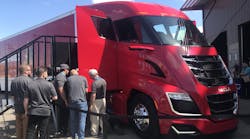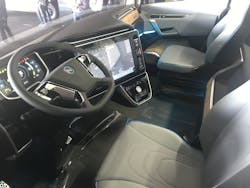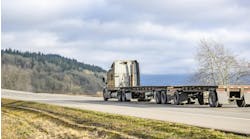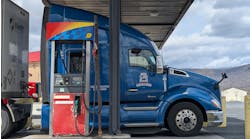SCOTTSDALE, AZ. Nikola Motor Co. aims to do more than just make hydrogen fuel cell heavy-duty trucks mainstream in the coming decade.
Executives from Nikola’s leadership team said they believe a new “all-in-bundle” leasing model will give fleet customers the ability to truly manage their total cost of ownership for the first time.
On April 16, the company unveiled the Nikola Two for the U.S. market, and the Nikola Tre for the European market. They will be offered in fuel cell and electric battery versions, and join the hydrogen fuel cell Nikola One model that was unveiled in late 2016.
When the trucks hits U.S. highways early in the next decade, leases of the Nikola One and Nikola Two are expected to cost 95 cents per mile, though company officials stressed that figure could change.
However, the lease includes not only the zero emission Class 8 tractor, but also maintenance, tires and fuel.
“It is the only semi-truck that can beat a diesel in every category,” said Trevor Milton, CEO of Nikola, when speaking about the company’s tractors.
The bundled leases are expected to run seven years or 700,000 miles. Milton told the more than 2,000 attendees at the recent two-day “Nikola World” event that maintaining a low cost of ownership is critical to the company’s success.
“If you don’t have a low enough cost of ownership, no one is going to buy them again,” Milton said.
Kim Brady, Nikola’s chief financial officer, said the company has three years’ worth of volume, based on existing order reservations. Brady added the ability to manage total costs is a powerful concept for fleets.
“How would it be for your management team and CFO to say, ‘I can predict my cost for the next seven years,’ ” he said, adding that Nikola is confident it can produce hydrogen at a reasonable cost.
Nikola will also sell trucks to fleets that want an outright purchase. Those fleets would then pay a lender a monthly payment, as well as a monthly fee to Nikola for fuel and maintenance, Brady said.
Before there is widescale production, Nikola plans to place trucks on the road with risk-sharing partners that will accumulate data.
“When things break, which they will, they’re going to work with us to get it fixed,” said Mark Russell, president of Nikola. “We’re going to learn a lot faster in this way than you would traditionally.”
The ‘chicken and egg’ of hydrogen
Nikola has built a hydrogen fueling station, which has one-ton capacity, at its headquarters in Phoenix. The manufacturer is working with Nel ASA to build out other stations.
Jon André Løkke, CEO of Nel ASA, said rolling out the hydrogen tractor and the fueling infrastructure together solves the issue of “the chicken and the egg,” while also driving down costs.
To help make this a reality, Nikola earlier this year signed a $16 million order to purchase equipment for the first phase of its fuel cell development laboratory.
“It is critical that we move fast and have the best equipment as part of our truck development process,” Russell said. “By creating our own facility, Nikola will be able to test and validate its fuel cell components in half the time it would take other OEMs and third-party labs.”
Jesse Schneider, executive vice president of hydrogen and fuel cell technology for Nikola, said the company will have the ability to simulate going to the Arctic Circle or Death Valley.
“All this is meant to accelerate the development simultaneously of the truck and the station, and that is what we’re doing here in Arizona,” he said.
An eight-ton hydrogen station is scheduled to be built in 2021 at an undisclosed location in California. Nikola ultimately plans more than 700 stations by 2028. It should take about 10 minutes to fuel a vehicle with a 600-mile range.
The stations likely will be built next to truck depots and can service heavy and light-duty vehicles. An eight-ton station and can fill 150 trucks per day, while locations with 300 to 600 vehicles will want a 32-ton facility, Schneider said.
At the stations, electricity is used to split water into oxygen and hydrogen, and the fueling stations will use renewable solar energy with low-carbon grid energy.
A new experience, inside and out
Both Milton and Russell said they foresee a future in which diesel vehicles are not allowed in many areas. That is already happening in some large cities, which are beginning to require the use of zero or near zero emission vehicles.
“This isn’t an evolution of a truck. This is a revolution,” said Jason Roycht, vice president of commercial vehicles for Bosch, which is working with Nikola.
Roycht detailed the truck’s safety and comfort features, including digital mirrors that offer aerodynamic and safety benefits.
“We can take the sunlight and reflection out. We have the ability to add night vision and driver assistance aids to the screens,” Roycht explained.
Nikola has a design and utility patent on its unobstructed mid-cab entry, allowing drivers to more easily enter from behind the seat.
Inside the cab, drivers can utilize voice controls rather than pushing buttons for executing commands and accessing data displays. Nikola also focused on infotainment options, with drivers able to download apps and have video conferencing capabilities.
Nikola’s trucks will use secure digital keys via a driver’s cell phone, and will know when a driver is approaching and lower the steps.
Milton noted he even focused on pets, saying it will be easy for drivers to travel with animals because the cab is fully climate controlled. The temperature can be displayed on windows, so passersby know pets are safe.
"I'm using my own personal experiences in my life to make sure our teams of engineers are building these features in," he said.
In summing up the overall vehicle, Steve Jennes, chief designer for Nikola, said he wanted a clean, simple profile with dynamic window graphics.
“From the front, I wanted a stance to the vehicle that was impactful,” he said.
The resulting shape is aerodynamic and spacious, Jennes said. There is four feet of room behind the driver’s seat, which can either hold a bed or create an office environment, depending on the model.
Nikola has partnered with Ryder System for maintenance. Dennis Cooke, president of fleet management solutions for Ryder System, said the company has 800 shops and 6,000 technicians that will be trained on Nikola’s equipment.





